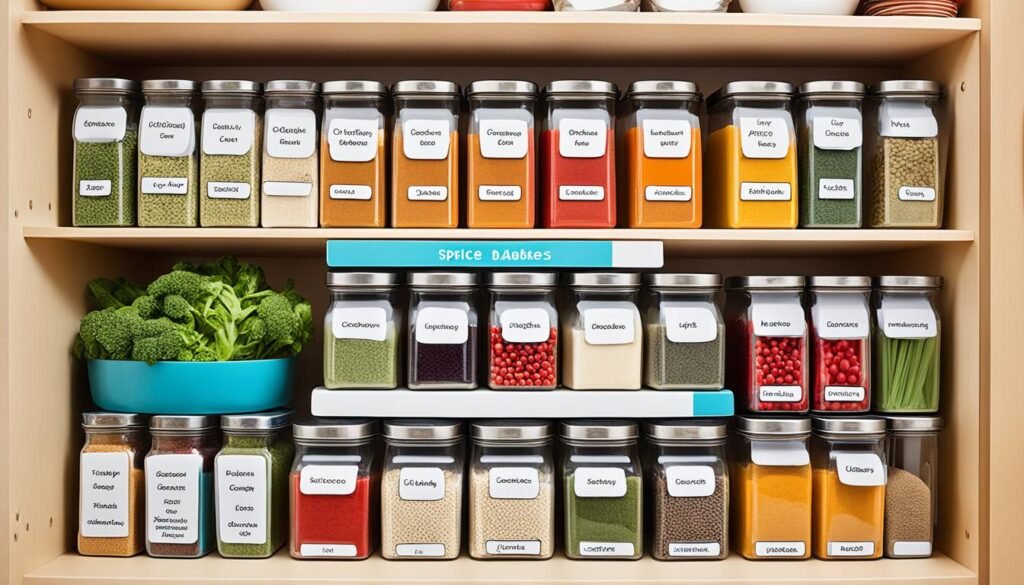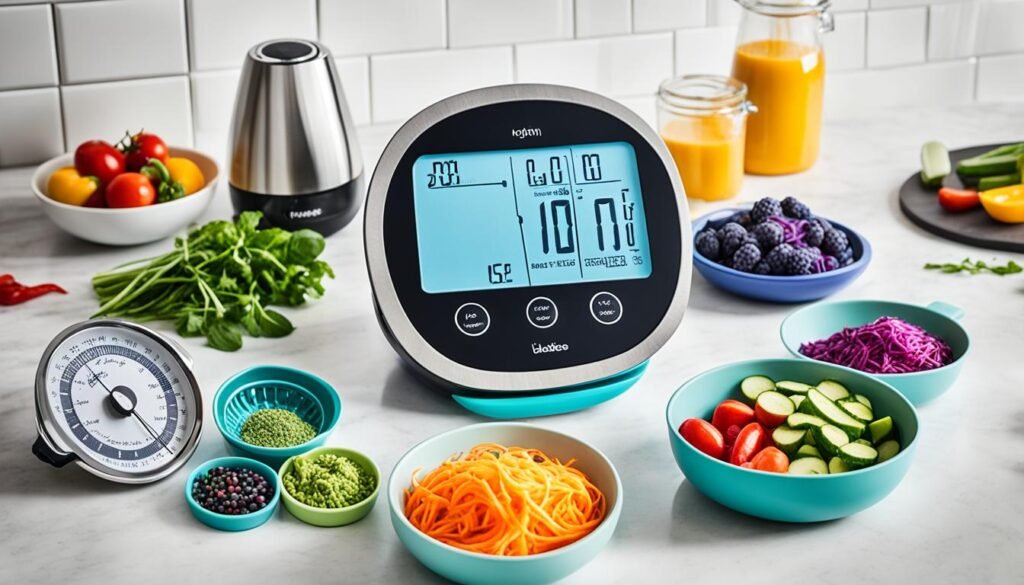Life’s challenges can turn into chances for growth. Brittany from The Happy Homemaker’s Tips proves this. Amidst the COVID-19 pandemic, her family faced type 2 diabetes and lost their main income. Yet, she faced everything bravely. She learned about diabetes-friendly meals and ways to make money from home. Her project, Happy Homemakers Tips, became a pillar of support and guidance for building a healthier home.
Several critical factors are necessary for a home that helps manage diabetes well. Organizing the kitchen, making detailed plans for diabetic meals, and mastering diabetic meal prep is vital. Thanks to Brittany, many know how to shop for budget-friendly diabetic groceries and use healthy cooking tools. She even showed how simple home gardening can deliver fresh, low-glycemic foods straight to your table.
Key Takeaways
- Creating a supportive environment is key in diabetes-friendly homemaking.
- Diabetes kitchen organization aids in more efficient and healthier meal prep.
- Diabetic meal planning is essential for maintaining balance and managing blood sugar levels.
- Intelligent shopping strategies can alleviate the cost of budget diabetic groceries.
- A home garden can contribute to a healthier diet and better diabetes management.
- Equipping the kitchen with healthy cooking tools is pivotal for diabetes-friendly food preparation.
- Effective stress management techniques are crucial in creating a healthier home amidst diabetes.
Introduction
Welcome to the world of diabetes-friendly homemaking. We focus on creating a healthy and supportive living space that meets the needs of people with diabetes. This method is not just about the place you live. It’s about creating a spot that helps manage diabetes well. You’ll learn many tips and strategies to make your home and life better for your health.
Knowing how a supportive home can help is crucial for managing diabetes daily. It’s more than making things easy. It’s about creating a haven that boosts well-being and lowers stress. This means setting up each part of your home, from the kitchen to the living room, to support healthy living and simplify managing diabetes.
We’ll show you how to use smart homemaking tips to aid your health aims. Changes can be anything from setting up your kitchen with good nutrition in mind to making peaceful spots around your home for less stress. Each part of this article gives ideas and steps for making a great living place for those with diabetes.
We’re excited to explore diabetes-friendly homemaking with you. Whether you plan small changes or big makeovers, we aim to help with knowledge and motivation. The path to a healthier and more supportive living space starts now, and we’re here to guide you at every step.
Organizing Your Kitchen for Diabetes-Friendly Cooking
Turning your kitchen into a diabetes-friendly zone starts with an innovative setup. Choose healthy foods and the right cooking tools. This makes meal prep easy, reduces unhealthy snacks, and promotes a balanced diet, which is key for diabetes management.
Tips for Stocking Healthy Foods
In your fridge and pantry, keep healthy foods easy to grab. Focus on fresh fruits and veggies, which are key for many diabetes-friendly dishes. Add whole grains like brown rice, lean proteins, and low-fat dairy. Position these items where you can see them. This will help you make better food choices.

Organizing Kitchen Tools for Easy Meal Prep
Use the right tools for diabetes-friendly cooking. Choose items that help cut down fat, like non-stick pans. Use tools for correct portion sizes, like food scales. Keep these tools handy in your kitchen for easy access.
| Healthy Cooking Tool | Purpose | Benefits for Diabetes |
|---|---|---|
| Measuring Spoons & Cups | Portion control | Aid in precise measurement for consistent carbohydrate intake |
| Vegetable Spiralizer | Alternate to pasta | Reduces carbs by replacing pasta with vegetables |
| Non-Stick Pans | Low-fat cooking | Minimizes the need for oils, reducing calorie and fat content |
| Air Fryer | Healthier frying alternative | Uses air to crisp food, lowering overall fat consumption |
| Food Scale | Portion weighing | Ensures accurate serving sizes for blood sugar management |
By organizing your kitchen for efficient meal prep, you create a space that supports diabetes-friendly cooking. This setup helps make cooking easier and more fun.
Meal Planning Strategies for Busy Families
Juggling work, school, and personal life with healthy eating is tough for busy families, especially those with diabetes. Meal planning helps ease daily stress and ensures meals are good for a diabetic diet. We’ll look at diabetic meal planning tips and the benefits of low-GI foods in a weekly meal plan.
Creating a Weekly Meal Plan
Starting a weekly meal plan gives families a routine. It prevents impulsive, unhealthy eating. Planning helps with efficient grocery shopping, cuts down food waste, and keeps nutrition in check. A plan means everyone knows what’s for dinner, making diabetes management more effortless.
Start by making a meal and snack chart for the week. This chart can be a fun addition to your kitchen. It helps everyone stay on track with daily meals.
| Day | Breakfast | Lunch | Dinner | Snack |
|---|---|---|---|---|
| Monday | Oatmeal with berries | Grilled chicken salad | Stir-fry with vegetables and tofu | Almonds and cheese |
| Tuesday | Yogurt and granola | Turkey wrap with avocado | Baked salmon with quinoa | Apple slices with peanut butter |
Keep a list of favorite, healthy recipes. This makes planning meals quicker and more enjoyable.
Incorporating Low GI Foods into Family Meals
Choosing low-GI foods is critical for people with diabetes because they don’t spike blood sugar much. Adding them to your weekly meal plan can be tasty and easy.
- Start with low GI basics like sweet potatoes, lentils, and whole grain bread.
- Go for low-GI fruits such as cherries, plums, and apples for snacks.
- Fill meals with non-starchy veggies, which are usually low GI.
- Pick whole wheat pasta and cook it al dente to lower its GI.
Families manage blood sugar and enjoy nutritious, tasty dishes by picking these foods for meals.
Remember, mastering meal planning and low-GI foods takes time for busy families. It’s about learning and adjusting gradually. With patience and creativity, it becomes a fun weekly task. It brings big rewards for those planning diabetic meals and wanting a balanced diet. The right approach and creativity are key to a healthy, bustling life.
Budget-Friendly Shopping for Diabetic Diets
Eating right with diabetes doesn’t have to be costly. Learn smart shopping strategies for diabetes-friendly foods. We share tips on when to buy certain items and how to make wise choices. This advice aims at keeping your diet healthy without draining your budget.
Shopping Smart and Saving
Planning is key to saving money on budget diabetic groceries. Compare prices, use coupons, and avoid sticking to one brand. These steps reduce costs significantly.
Seasonal Shopping Tips
Buying fruits and vegetables in their season is wise. They are fresher, better for you, and cheaper. Plan your meals with what’s in season to enjoy fresh food while saving money.
| Season | Produce | Cost-Saving Tips |
|---|---|---|
| Spring | Asparagus, Strawberries, Spinach | Buy in bulk and freeze for later. |
| Summer | Tomatoes, Peaches, Bell Peppers | Explore local farmer’s markets for deals. |
| Fall | Pumpkins, Apples, Sweet Potatoes | Purchase from roadside stands or pick-your-own farms. |
| Winter | Kale, Squash, Citrus Fruits | Look for sales on holiday overstock. |

Diabetes-Friendly Home Gardening
Starting a garden focused on diabetes-friendly home gardening is a big move towards health. Gardening gives you fresh, nutritious food and increases physical activity. Remember a few key points and plant types if you’re looking to start a vegetable garden for blood sugar control.
Starting a Small Vegetable Garden
Starting a home vegetable garden involves simple steps. First, pick a spot with plenty of sun and good soil. Begin with a small area to keep things easy to manage. Consider raised beds or containers if space or mobility is a concern. Make sure to water regularly and keep pests away. Gardening is great for home gardening diabetes management, as it helps with blood sugar regulation.
Best Plants for Blood Sugar Levels
To pick the best plants for blood sugar levels, choose veggies and herbs that are low in glycemic index. Also, go for those high in fiber, vitamins, and minerals. Here’s a table of the top picks for your garden:
| Plant Type | Benefits | Suggested Varieties |
|---|---|---|
| Leafy Greens | High in fiber, low in calories | Spinach, Kale, Swiss Chard |
| Cruciferous Vegetables | Rich in antioxidants and phytonutrients | Broccoli, Cauliflower, Cabbage |
| Legumes | Good source of plant-based protein | Beans, Lentils, Peas |
| Herbs | Helps reduce blood sugar levels | Cilantro, Mint, Parsley |
| Low GI Fruits | Help manage blood sugar spikes | Berries, Pears, Apples |
Getting into diabetes-friendly home gardening is more than a pastime—it’s a step towards better eating. You’ll have a garden that supports stable blood sugar by choosing the right plants. Also, enjoying the fruits of your hard work will boost your health and happiness.
It’s worth mentioning that The Happy Homemakers Tips proudly participates in the Amazon Services LLC Associates Program, an affiliate advertising program designed to enable sites to earn advertising fees by advertising and linking to amazon.com and affiliated sites. If you click on an affiliate link and make a purchase, we will receive a small commission at no extra cost. It’s one of the ways we keep the lights on and bring you awesome content. Thanks for your support!
Crafting a Diabetic-Friendly Kitchen Environment
For people with diabetes, the kitchen is more than a cooking space. It’s a key area for maintaining a healthy lifestyle. A diabetic-friendly kitchen helps reduce unhealthy temptations and provides tools for healthier meal preparation, which will make a big difference in daily life.
When you have the tools you need, you’re more likely to use them. That’s why equipping your kitchen with healthy cooking tools specifically for diabetes can lead to better dietary choices and improved health outcomes.
Essential Gadgets and Tools
Adding particular gadgets to your kitchen makes cooking easier and healthier. Some must-have items include:
- Food scales for precise portion control
- Non-stick cookware to reduce the need for excessive oils
- Steamers for retaining nutrients while cooking vegetables
- Blenders for healthy smoothies and soups
Remember, investing in healthy cooking tools designed for diabetes management can lead to a lifelong habit of healthy cooking and eating.
Minimizing Temptations
It’s also important to create a kitchen that supports healthy eating. One way is by keeping unhealthy snacks out of sight. This reduces the chance of impulsive eating that can upset blood sugar levels.

- Store tempting sweets and processed snacks in higher cabinets or out of the kitchen entirely.
- Place healthier alternatives, like fresh fruits and vegetables, at eye level in the fridge or on the countertop.
- Use clear storage containers for portioned, healthy meals, making them the easy choice.
By focusing on a diabetic-friendly kitchen, you support daily healthy choices. This helps in better diabetes management.
| Tool | Use | Diabetic Benefits |
|---|---|---|
| Portion Control Plates | Meal serving | Enforces portion sizes to manage intake |
| Vegetable Spiralizer | Preparing vegetables | Creates healthy alternatives to high-carb pasta |
| Air Fryer | Cooking with less oil | Reduces added fats in the diet |
| Slow Cooker | Low-effort meals | Helps in preparing nutrient-dense, low-GI dishes |
Creating a kitchen that’s diabetic-friendly is crucial. It should be both practical and enjoyable to use. This is a vital step in making healthy choices and controlling diabetes.
Homemaking Hacks for Better Blood Sugar Control
Creating a healthy home is crucial for those with diabetes. It’s about more than just food and medicine. The environment you live in can affect your blood sugar. We’ll look at homemaking tips that help control blood sugar. These hacks make cleaning easier and add peace to your home. They’re designed to help manage diabetes better.
Quick Clean-Up Strategies
A clean home is key for diabetes care. Less clutter means less stress and a peaceful place that promotes health. Start by having quick cleaning methods. This turns cleaning from a big chore into a simple part of your day. Put things you use a lot in the same place always. Use smart ways to store things so your home looks neat and everything’s easy to find. Quick tidying up helps manage diabetes by saving time and reducing stress.
Creating a Stress-Free Home Environment
Stress makes diabetes harder to manage. Using ways to reduce stress at home can really help control blood sugar. A calm home includes and excludes certain things. Add things like soft lights, cozy colors, or plants. They clean the air and add calm. Make a special spot for relaxing or mindfulness. It could be for meditation, yoga, or just to relax. This creates a peaceful retreat. It’s a big step in managing stress and diabetes.LAnd just a friendly reminder, don’t miss out on a guide I mentioned earlier, Diabetic Diet: Essential Guide for Healthy Living. It’s been incredibly helpful to me, and I think you’ll find it valuable too. Here’s to making our homes healthier and happier!